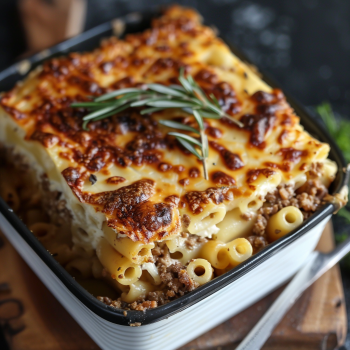
Pastitsio the Greek Lasagna
Pastitsio, often referred to as Greek lasagna, is a sumptuous and hearty dish that combines layers of pasta, a rich meat sauce, and a creamy béchamel topping. This traditional Greek dish is a staple at festive gatherings and a beloved comfort food for families around the world. In this comprehensive guide, we will explore the steps to creating an authentic Pastitsio, ensuring each layer melds perfectly to deliver a memorable dining experience. #greek pastichio
Pastitsio Ingredients Overview
Main Components
- Pasta: Tubular pasta like ziti or penne is ideal for holding the meat sauce.
- Ground Beef or Lamb: Choose lean meat for the best texture and flavor.
- Tomato Paste: Concentrated tomato flavor enriches the meat sauce.
- Cinnamon and Nutmeg: These spices are essential for authentic Greek flavor.
- Parmesan Cheese: Adds a salty, nutty flavor to the béchamel sauce.
- Butter: Forms the base of the roux.
- Flour: Thickens the sauce.
- Milk: The creaminess of whole milk enhances the sauce’s texture.
- Egg Yolks: Help thicken and enrich the sauce, giving it a glossy finish.
Step-by-Step Cooking Process
Preparing the Pasta
- Boil the Pasta: Cook the pasta al dente according to package instructions. Drain and set aside.
- Season: Toss the pasta in a touch of olive oil and a pinch of nutmeg to enhance the flavor.
Making the Meat Sauce
- Sauté Aromatics: Begin by sautéing onions and garlic until translucent.
- Brown the Meat: Add the ground meat, breaking it apart. Cook until browned.
- Add Spices and Tomato Paste: Stir in cinnamon, nutmeg, and tomato paste. Cook for a few minutes to develop the flavors.
- Simmer: Add a splash of red wine and let the sauce simmer to thicken slightly, enhancing its richness.
Crafting the Béchamel Sauce
- Make Roux: Melt butter in a saucepan, whisk in flour until smooth.
- Add Milk: Gradually add milk, stirring continuously to prevent lumps.
- Thicken Sauce: Cook until the sauce thickens and coats the back of a spoon.
- Season and Enrich: Season with salt, pepper, and a dash of nutmeg. Stir in beaten egg yolks and parmesan cheese off the heat.
Assembling the Pastitsio
- Layer the Pasta: Create a base layer of pasta in a greased baking dish.
- Add Meat Sauce: Spread the meat sauce evenly over the pasta.
- Top with More Pasta: Add another layer of pasta on top of the meat sauce.
- Cover with Béchamel Sauce: Pour the béchamel sauce over the top layer, smoothing out to cover completely.
Baking
- Bake: Cook in a preheated oven at 350°F (175°C) for about 40 minutes, or until the top is golden and bubbly.
- Rest: Allow the pastitsio to rest for 10-15 minutes before slicing. This helps the layers set, making it easier to serve.
Serving Suggestions
Pastitsio is best served warm, with a side of crusty bread and a fresh salad, such as a Greek salad with feta cheese and olives. It pairs wonderfully with a glass of robust red wine, enhancing the rich flavors of the dish.
Conclusion
Pastitsio is more than just a meal; it’s a beloved Greek tradition that brings people together. With its layers of flavorful meat, pasta, and creamy béchamel, it’s a dish meant to be shared and savored. Follow this guide to bring a taste of Greece into your home, and enjoy the process of cooking a dish that’s steeped in culinary tradition.
Embedded Internal Links
- Greek Salad Recipe
- Greek Lemon Chicken
- Manuka Honey Health Benefits
- Vegetarian Recipes
- Greek Christmas Traditions
- Refreshing Mediterranean Greek Salad
- Best Greek Cheeses
- Greek Yogurt Benefits
- Greek Food Festivals
- Greek Language and Culture
- Tradition of Greek Breads
- Sesame Bread Rings
- Greek Meatballs Meze
- Hot and Cold Cereal Bowls
- Greek Coffee Essentials
- Cultural Heritage of Greece
- Best Greek Olives
- Freddo Espresso
- Greek Lemon Chicken Soup


















